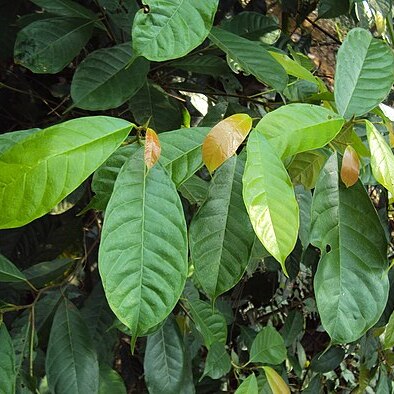Trees, pubescent, glabrescent. Branchlets wrinkled when dry. Petiole 1-2 cm; leaf blade elliptic, oblong, or obovate-lanceolate, 6-15(-20) × 2.5-5 cm, ± leathery, glabrous, abaxially dark colored with small scattered tubercles, adaxially dark green but brown when dry and shiny, base rounded to cuneate and with two glands, margin entire and ± revolute, apex obtuse and mucronate; basal lateral veins short, with axillary glands, secondary veins 7-11 on each side of midvein and abaxially prominent. Figs axillary on normal leafy stem, paired or solitary, globose to ± globose, 1-1.2 cm in diam., tuberculate when young, base attenuate into an apparent stalk, sessile; involucral bracts ovate, pubescent. Male, gall, and female flowers within same fig. Male flowers: near apical pore, pedicellate; calyx lobes 2, spatulate, unequal in size; stamen 1. Gall flowers: pedicellate or sessile; calyx lobes 3, elongated, apex acuminate; style lateral; stigma clavate. Persistent style 2 × as long as achene. Fl. Jan-Aug.
More
A fig. It is a tree. The leaf stalk is 1-2 cm long. The leaf blade is oval and 6-15 cm long and 2.5-5 cm across. It is thinly leathery. It is dark green on top and dark with small scattered lumps underneath. The base is round, the edges curl and the tip is sharp. There are 7-11 side veins each side of the main vein. These are easy to see underneath. The figs occur either singly or in pairs in the axils of leaves. They are round and 1-1.2 cm across. They are lumpy when young. They do not have a stalk but the fruit narrow looking like a stalk. Male, gall and female flowers occur in the same fig.


